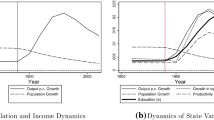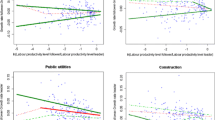Abstract
Can we associate globalization with converging productivity levels of different countries? Are developing countries catching up? This paper provides answers to these questions by studying the convergence of labor productivity with the Penn World Table 10.0. I utilize standard \(\beta \)- and \(\sigma \)-tests and the new \(\sigma \)-test Kong et al. (J Econom 209(2):185–207, 2019) propose. Furthermore, I propose using a time-series trend test to further study the underlying process of \(\sigma \)-convergence. The tests support convergence in the country groups of OECD, EU, APEC, Europe, and Asia. Contrary to the current belief that the income gap between rich and poor countries is not closing, I find \(\sigma \)-convergence in a group that excludes only African countries. More so, even the group of all countries seems to converge from the year 2000.




Similar content being viewed by others
Data availability
All data used (PWT10.0) is publicly available and all codes for replication are available upon request.
Notes
The overall number of countries in the dataset is 183, from which 176 countries are covered with data to calculate productivity for at least one of the periods considered. See appendix A.
See also Quah (1993) for slightly different definitions of convergence.
Dufrenot et al. (2012) and Stengos and Yazgan (2014) extend the standard time-series approach to cover a possible long memory parameter. Stengos and Yazgan (2014) also allow for structural breaks. However, Stengos and Yazgan (2014) conclude that the standard approach is sufficient to capture the behavior of the output gaps even, while the long memory framework is information-richer.
I also report the \(\beta \)-convergence tests. This is because, as Sala-i-Martin (1996b) and Lichtenberg (1994) point out, \(\beta \)-convergence is a necessary condition for \(\sigma \)-convergence. Furthermore, Sala-i-Martin (1996a, 1996b) argue that both concepts are interesting, whereas Bernard and Durlauf (1996) state that the cross-sectional tests are more suited to data containing transitional countries.
See, for example, Madsen (2010) for empirical evidence on the possible growth mechanism.
In appendix B, \(T_{1}\) refers to the original Lichtenberg’s ratio of variances test. I use the adjusted version \(T_{2}\) instead.
To calculate labor productivity, I use employment rather than hours worked since this increases the number of observations notably.
Most of the excluded countries are island countries in the Americas. I exclude Venezuela from the sample because the extreme decrease in GDP during 2013–2019. In this period, according to the PWT10.0 data, living standards GDP and productive capacity GDP drop 99 %, and national accounts GDP 67 %.
Note that Rodrik (2013)’s claim concerns country-level convergence while the study finds that unconditional convergence exists within manufacturing industries.
Overall, whether I use GDP per capita instead of labor productivity has little effect on the results. Moreover, all the main findings and conclusions in this paper stay the same.
See Appendix A for countries involved in each club.
To name some: Community of Sahel-Saharan States, Common Market for Eastern and Southern Africa, Southern African Development Community and Economic Community of West African States.
References
Aghion P, Howitt P (1992) A model of growth through creative destruction. Econometrica 60(2):323–351
Barro RJ (1991) Economic growth in a cross section of countries. Q J Econ 106(2):407–443
Barro RJ (2015) Convergence and modernisation. Econ J 125(585):911–942
Barro RJ, Sala-i-Martin X (1992) Convergence. J Polit Econ 100(2):223–51
Bartlett MS (1954) A note on the multiplying factors for various \(\chi ^{2}\) approximations. J R Stat Soc Ser B (Methodol) 16(2):296–298
Baumol WJ (1986) Productivity growth, convergence, and welfare: what the long-run data show. Am Econ Rev 76(5):1072–85
Bernard AB, Durlauf SN (1995) Convergence in international output. J Appl Econom 10(2):97–108
Bernard AB, Durlauf SN (1996) Interpreting tests of the convergence hypothesis. J Econom 71(1):161–173
Bernardini Papalia R, Bertarelli S (2013) Nonlinearities in economic growth and club convergence. Empir Econ 44(3):1171–1202
Binder M, Pesaran MH (1999) Stochastic growth models and their econometric implications. J Econ Growth 4(2):139–183
Brynjolfsson E, Rock D, Syverson C (2021) The productivity j-curve: how intangibles complement general purpose technologies. Am Econ J Macroecon 13(1):333–72
Carree M, Klomp L (1997) Testing the convergence hypothesis: a comment. Rev Econ Stat 79(4):683–686
Comin D, Hobijn B (2010) An exploration of technology diffusion. Am Econ Rev 100(5):2031–59
Comin DA, Gonzalez JQ, Schmitz TG, Trigari A (2020) Measuring TFP: the role of profits, adjustment costs, and capacity utilization. NBER Working Paper Series 28008
Desdoigts A (1999) Patterns of economic development and the formation of clubs. J Econ Growth 4(3):305–30
Dickey DA, Fuller WAF (1979) Distribution of the estimators for autoregressive time series with a unit root. J Am Stat Assoc 74(366a):427–431
Dobson S, Ramlogan C, Strobl E (2006) Why do rates of \(\beta \)-convergence differ? A meta-regression analysis. Scot J Polit Econ 53(2):153–173
Dufrenot G, Mignon V, Naccache T (2012) Testing catching-up between the developing countries: “growth resistance’’ and sometimes “growth tragedy’’. Bull Econ Res 64(4):470–508
Durlauf SN, Johnson PA (1995) Multiple regimes and cross-country growth behaviour. J Appl Econom 10(4):365–384
Egger P, Pfaffermayr M (2009) On testing conditional sigma-convergence. Oxf Bull Econ Stat 71(4):453–473
Elliott G, Rothenberg TJ, Stock JH (1996) Efficient tests for an autoregressive unit root. Econometrica 64(4):813–836
Feenstra RC, Inklaar R, Timmer MP (2015) The next generation of the Penn world table. Am Econ Rev 105(10):3150–3182
Friedman M (1992) Do old fallacies ever die? J Econ Lit 30(4):2129–2132
Galor O (2005) Chapter 4 from stagnation to growth: unified growth theory. Volume 1 of Handbook of Economic Growth, pp 171 – 293. Elsevier
Harvey DI, Leybourne SJ, Taylor AR (2007) A simple, robust and powerful test of the trend hypothesis. J Econom 141(2):1302–1330
Harvey DI, Leybourne SJ, Taylor AR (2012) Testing for unit roots in the presence of uncertainty over both the trend and initial condition. J Econom 169(2):188–195
Howitt P (2000) Endogenous growth and cross-country income differences. Am Econ Rev 90(4):829–846
Howitt P, Mayer-Foulkes D (2005) R &d, implementation, and stagnation: a Schumpeterian theory of convergence clubs. J Money Credit Bank 37(1):147–177
Islam N (1995) Growth empirics: a panel data approach. Q J Econ 110(4):1127–1170
Johansen S (1991) Estimation and hypothesis testing of cointegration vectors in Gaussian vector autoregressive models. Econometrica 59(6):1551–1580
Johnson P, Papageorgiou C (2020) What remains of cross-country convergence? J Econ Lit 58(1):129–75
Kong J, Phillips PC, Sul D (2019) Weak \(\upsigma \)-convergence: theory and applications. J Econom 209(2):185–207
Kwiatkowski D, Phillips PC, Schmidt P, Shin Y (1992) Testing the null hypothesis of stationarity against the alternative of a unit root: How sure are we that economic time series have a unit root? J Econom 54(1):159–178
Lee K, Pesaran MH, Smith R (1997) Growth and convergence in a multi-country empirical stochastic Solow model. J Appl Econom 12(4):357–392
Lichtenberg FR (1994) Testing the convergence hypothesis. Rev Econ Stat 76(3):576–579
Madsen JB (2010) The anatomy of growth in the OECD since 1870. J Monet Econ 57(6):753–767
Madsen JB, Timol I (2011) Long-run convergence in manufacturing and innovation-based models. Rev Econ Stat 93(4):1155–1171
Mankiw NG, Romer D, Weil DN (1992) A contribution to the empirics of economic growth. Q J Econ 107(2):407–437
Morrison DF (2005) Multivariate Statistical Methods, 4th edn. Duxbury Press, Pacific Grove
Moss E, Nunn R, Shambaugh J (2020) The slowdown in productivity growth and policies that can restore it. The Hamilton Project, Brookings Institution, Washington, DC
Newey WK, West K (1994) Automatic lag selection in covariance matrix estimation. Rev Econ Stud 61(4):631–653
Pesaran MH (2007) A pair-wise approach to testing for output and growth convergence. J Econom 138(1):312–355
Quah DT (1993) Galton’s fallacy and tests of the convergence hypothesis. Scand J Econ 95(4):427–443
Quah DT (1996) Empirics for economic growth and convergence. Eur Econ Rev 40(6):1353–1375
Quah DT (1997) Empirics for growth and distribution: stratification, polarization, and convergence clubs. J Econ Growth 2(1):27–59
Rodrik D (2013) Unconditional convergence in manufacturing. Q J Econ 128(1):165–204
Sala-i-Martin X (1996) The classical approach to convergence analysis. Econ J 106(437):1019–1036
Sala-i-Martin X (1996) Regional cohesion: evidence and theories of regional growth and convergence. Eur Econ Rev 40(6):1325–1352
Solow RM (1956) A contribution to the theory of economic growth. Q J Econ 70(1):65–94
Stengos T, Yazgan ME (2014) Persistence in convergence. Macroecon Dyn 18(4):753–782
Summers R, Heston A (1988) A new set of international comparisons of real product and price levels estimates for 130 countries, 1950–1985. Rev Income Wealth 34(1):1–25
Swan TW (1956) Economic growth and capital accumulation. Econ Rec 32(2):334–361
White H (1980) A heteroskedasticity-consistent covariance matrix estimator and a direct test for heteroskedasticity. Econometrica 48(4):817–38
Yang Y, Wang S (2017) Two simple tests of the trend hypothesis under time-varying variance. Econ Lett 156(C):123–128
Funding
This work was supported by Palkansaajasäätiö.
Author information
Authors and Affiliations
Corresponding author
Ethics declarations
Conflict of interest
The author has no competing interests to declare that are relevant to the content of this article.
Additional information
Publisher's Note
Springer Nature remains neutral with regard to jurisdictional claims in published maps and institutional affiliations.
I gratefully acknowledge the funding provided by Palkansaajasäätiö.
Supplementary Information
Below is the link to the electronic supplementary material.
Rights and permissions
Springer Nature or its licensor (e.g. a society or other partner) holds exclusive rights to this article under a publishing agreement with the author(s) or other rightsholder(s); author self-archiving of the accepted manuscript version of this article is solely governed by the terms of such publishing agreement and applicable law.
About this article
Cite this article
Lähdemäki, S. Cross-country convergence: to be or not to be, that is the question. Empir Econ (2024). https://doi.org/10.1007/s00181-024-02561-8
Received:
Accepted:
Published:
DOI: https://doi.org/10.1007/s00181-024-02561-8




